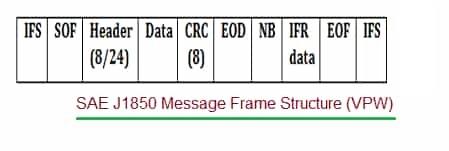J1850 Protocol: Key Benefits, Features & Limitations
Advertisement
Introduction : The J1850 protocol delivers a legacy standard for vehicle diagnostics (including PWM and VPW variants) and offers simplicity and broad compatibility with older vehicles.
What is J1850?
It was primarily used in vehicles from the 1990s and early 2000s, J1850 was a key protocol for on board diagnostics (OBD-II) and communication between various electronic control units (ECUs) before the widespread adoption of the Controller Area Network (CAN) bus.
The frame of J1850 contains a Start of Frame, a Header, a Data payload, a Cyclic Redundancy Check (CRC) and an End of Frame.

It was developed by the Society of Automotive Engineers (SAE). It facilitated the exchange of data for functions like engine and transmission control, emissions monitoring and diagnostics.
PWM and VPW
-
J1850 PWM (Pulse Width Modulation): This version was predominantly used by Ford. It operated at a data rate of 41.6 kbps and utilized a two wire differential signaling approach.
-
J1850 VPW (Variable Pulse Width): General Motors, on the other hand, favored the J1850 VPW standard. This version had a slower data rate of 10.4 kbps and employed a single wire communication bus.
Advantages of J1850
Following are some of the benefits of J1850.
- Both single wire VPW and dual wire PWM are relatively low cost networking solutions.
- As component of OBD-II, J1850 provides standardized way for external device to communicate with ECU of vehicle compared to other proprietary approaches.
- It simplifies in-vehicle communication between various modules.
- J1850 is a masterless protocol, meaning any ECU can initiate communication. Moreover it implements CSMA/CR which handles issues pertaining to simultaneous transmission by multiple ECUs.
- It uses CRC (Cyclic Redundancy Check) which handles error detection and hence ensures integrity and accuracy of transmitted data.
Disadvantages of J1850
Following are some of the limitations of J1850.
- It supports lower data rates i.e. 10.4 kbps for VPW and 41.6 kbps for PWM. Hence it is significantly slower than modern protocols.
- As it has limited scalability, it is not suitable for rapidly growing number of electronic systems in vehicles.
- J1850 is being phased out due to availability of more advanced protocols such as CAN and its variants. These latest protocols offer higher speeds which is up to 1 Mbps and beyond.
- Both PWM and VPM versions are incompatible. This requires to be checked while using specific tools for diagnosis of ECUs.
Conclusion: By weighing the benefits and limitations of the J1850 protocol, automotive engineers and technicians can appropriately support legacy vehicles, understand why modernization is required and plan diagnostics and system upgrades accordingly.
Advertisement
 RF
RF





